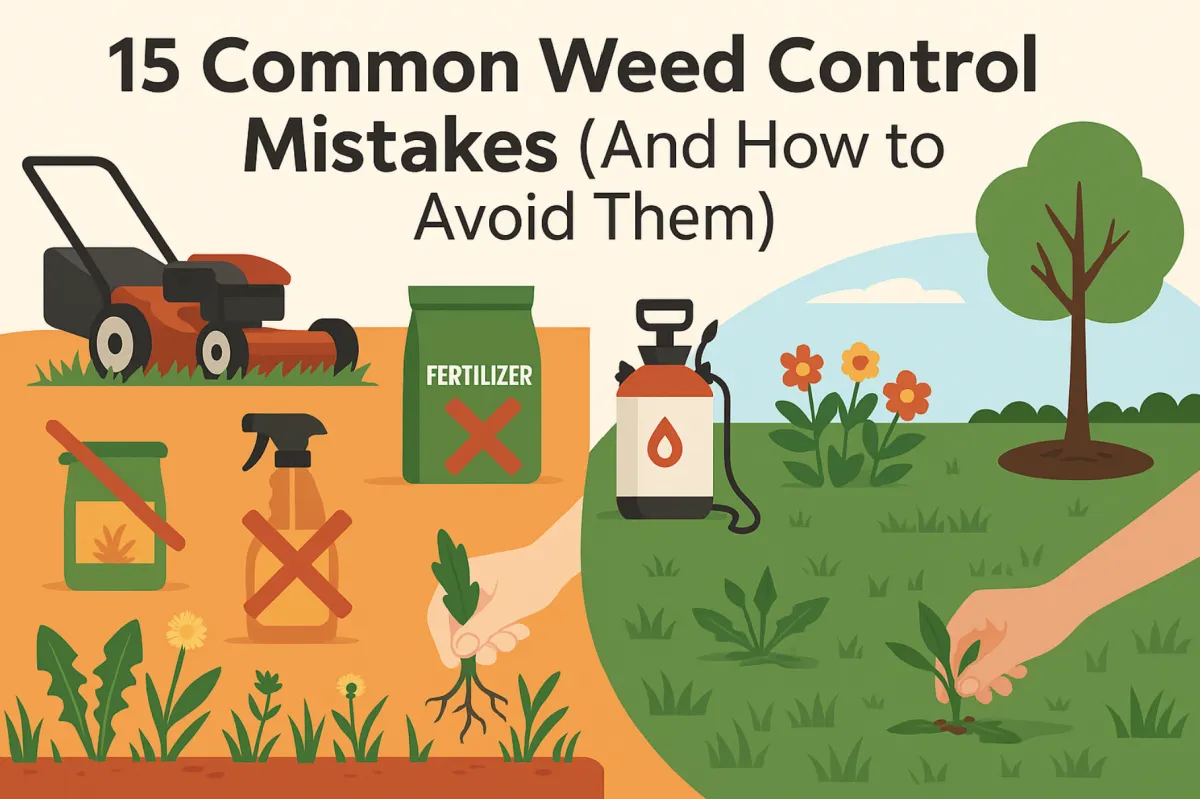
15 Common Weed Control Mistakes (And How to Avoid Them)
Keeping a healthy, thriving lawn or garden requires more than regular watering and mowing—it also means staying on top of weed control. But even with the best intentions, many homeowners make avoidable mistakes that allow weeds to gain the upper hand.
Here are the most common weed control mistakes and how to correct them for a cleaner, greener yard.
1. Mowing Too Short or Infrequently
Cutting your grass too short or waiting too long between mows weakens your turf and invites weeds. Taller, healthy grass (about 3 inches in summer) naturally shades out weed seeds and outcompetes them for resources.
2. Skipping Fertilizer
Fertilizer doesn’t kill weeds directly—but it does grow thicker, stronger grass that can choke them out. If you’re only mowing and not feeding your lawn, weeds may win the battle for nutrients and space.
3. Using the Wrong Herbicide
There are two main types:
Pre-emergent herbicides prevent seeds from sprouting—use in early spring/fall.
Post-emergent herbicides kill existing weeds—apply when weeds are already visible.
Misapplying either type can reduce effectiveness and delay control.
4. Relying on Natural Remedies That Don't Work
DIY methods like vinegar, soap, or essential oils may burn weed tops but don’t kill roots. These are best for small, isolated problems—not widespread outbreaks. And "natural" commercial herbicides aren’t always backed by strong evidence.
5. Applying Products Incorrectly
From skipping gloves to spraying before rain, user error reduces effectiveness and increases risk. Always follow label instructions and wear proper protection.

6. Spraying Herbicide on Bare Soil
Post-emergent weed killers only work on visible weeds. Spraying bare dirt won’t prevent growth and may even prevent your grass or plants from sprouting if you're planning to seed.
7. Pulling Only the Tops
Grabbing the top of a weed won’t stop it from coming back. For lasting control, remove the entire plant—roots and all—especially before it goes to seed.
8. Not Using Tools When You Should
For mature or widespread weeds, hand-pulling isn’t enough. Tools like digging forks, weed knives, and hoes help remove tough root systems efficiently.
9. Forgetting Gardening Gloves
Pulling weeds barehanded can expose you to bacteria in soil like E. coli or Clostridium. Always use gloves—even for quick jobs.
10. Leaving Pulled Weeds on the Ground
Pulled weeds left on the soil can re-seed or re-root. Dispose of them immediately in a sealed bag and trash them properly.
11. Watering Weed Seedlings
Automatic sprinklers often water everything, helping weed seeds grow. A drip system or hand-watering is better for targeted hydration and weed control.
12. Relying on Weed Fabric Alone
Landscape fabric can help, but it’s not foolproof and may degrade soil quality. Plus, weeds can grow through or around it over time. Use fabric with mulch and maintain regularly.
13. Skipping Mulch
Mulch blocks sunlight and helps retain moisture, but don’t overdo it. Aim for 3 inches around plants and 6 inches in bare beds. Over-mulching can suffocate roots and encourage mold.
14. Tilling at the Wrong Time
Tilling is helpful before planting but not for established lawns or large, existing weeds. Use it 2–4 weeks before seeding, and never as a quick fix mid-season.
15. Waiting Too Long to Act
Weed control is a year-round task. Don’t wait for a “perfect day” or hope winter will solve the problem. Use pre-emergents in early spring, and pull or spot-spray weeds as they appear.
A few well-timed strategies—like mowing correctly, using the right herbicide, and pulling weeds early—can save you a lot of headache later in the season. Stay consistent and proactive, and your lawn or garden will thank you.

